| |
A couple of months ago, we went on a mountain vegetable-picking trip with some of our local friends. Because we had no prior experience cooking almost everything we picked, we solicited cooking tips as well. For one plant, koshiabura, a friend recommended tossing it with cooked spaghetti and pepperoncini. Japanese cooking borrows a lot from other cuisines, so I didn't think the suggestion to combine a humble mountain plant with imported Italian peppers was too offbeat. I certainly didn't think to ask whether she meant something entirely different.
Before dinner, I headed off to the store for ingredients. Regular grocery store: no pepperoncini. Booze and imported goods store: no pepperoncini. Posh department store: no pepperoncini. I was running out of time, so I made a lateral flavor jump to capers instead. The spaghetti was good, but I wondered how different it would be with the pepperoncini. It was only much later that I started wondering whether our friend had meant pickled peppers at all.
So I asked recently. "When you said 'pepperoncini,' what did you mean?" "Garlic and togarashi (Japanese red pepper). Why?" I explained the futile hunt for small yellow pickled peppers, and we both got a big laugh out of it. But next time, I'm asking what she means if she says something Western.
[ 2 comments ] permalink
During dinner at the local Okinawan joint, we ordered a new-to-us dish that came with a mystery seafood topping. We asked about it, and got an answer we didn't understand: shi-chikin. While the owner's son disappeared into the back, we consulted the electronic dictionary, but couldn't find anything under a listing for shi-chikin. It all became clear when he brought out a small can and pointed to the mermaid on the side. Sea chicken. Chicken of the Sea. Canned tuna. Canned tuna has an odd place in Japanese cooking. We find it where we'd expect to: in sandwiches and salads. We also find it where we wouldn't expect to: on pizza, in those prepackaged, unrefrigerated sandwiches with the edges pressed together and the crusts cut off, in onigiri (rice balls). It reaches the pinnacle of awesomeness in onigiri. There's no better convenience snack than a tuna-mayo onigiri ¡½ the creamy, salty tuna, the sticky, slightly sweet rice, and the crisp, ocean-y nori are perfect together. Additionally, tuna keeps company with an unlikely sidekick: yellow corn (corn in Japanese cooking is another subject entirely). They're a surprisingly tasty duo ¡½ corn and tuna pizza is far from the worst thing I've ever eaten. Salads now seem to lack something if they come with one or the other, but not both. Which raises a question: does the normalization of the tuna/corn partnership mean we've been here too long? It's likely that question will only linger until the next discovery of canned tuna in a completely unexpected place.
Yesterday, we went to Battari-mura, where we observed villagers making tofu the all-natural, old-school way. Tofu-making has a lot in common with cheesemaking, what with all the boiling, pressing, straining, and coagulating of curds. It's hot work, but the end product is well worth it. At Battari-mura, step one of the process involved grinding cooked soybeans with a hand-crank-operated stone mill, complete with straw-and-bucket drip system  After the beans are ground, the resulting mash is boiled for a time, then scooped into a machine where it is pressed in a hand-crank-operated machine (what else?) to extract the soy milk. 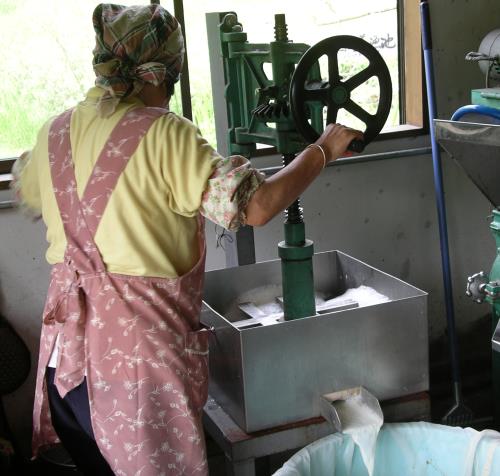 Salts or acids are added to the milk to cause the proteins to coagulate (or, as the maker said, "form a katamari"). It takes a little while for coagulation to occur, but once it does, it happens quickly. 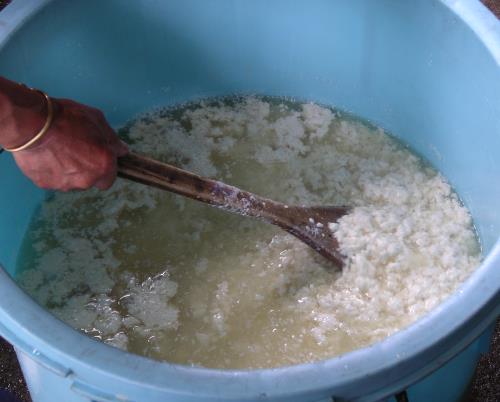 There's more processing involved to get blocks of tofu, but since we were there in part to eat tofu, the woman making it simply scooped the curds out of the bucket and drained them before serving them to us. 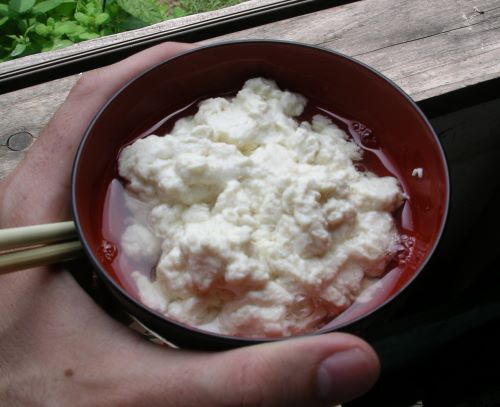 Mmm . . . fresh, delicious tofu.
[ 1 comment ] permalink
There's a little puffery involved in any kind of advertising, but I wonder if Suntory hasn't gone just a leetle bit over the line here: 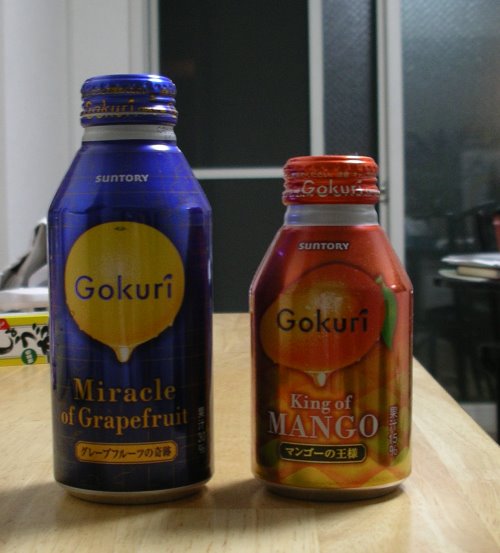 The Miracle is more delicious than the King, and both are far superior to their compatriot, the less extravagantly named " Sweet Lemon." Maybe Suntory is on to something, although I haven't developed superpowers or anything after drinking the Miracle.
The best thing about summer in Japan: Yamagata cherries. 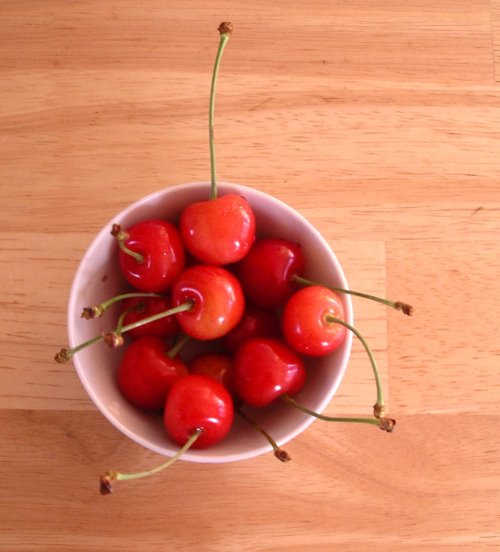 Yamagata Prefecture is famous for its cherries, which are very sweet and beautiful. They can be very expensive ¡½ the posh department store sells large boxes of them, carefully stemmed and arranged into rows, for around 3,000 yen or USD $30. These are not so precious, but man, are they delicious.
Or, "Where It All Began." 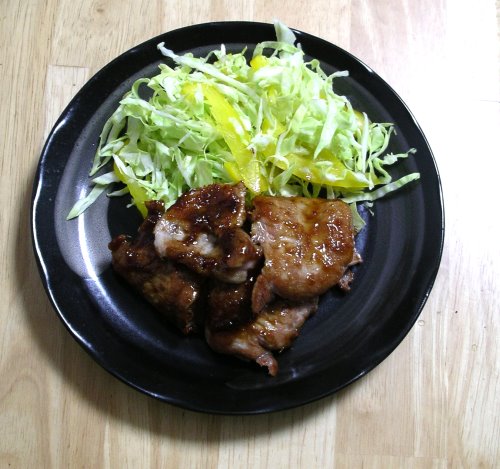 This is shouga-yaki, or ginger-glazed pan-fried pork. It was the first dish Matthew made out of his brand-new Japanese cookbook, and later, the first dish he made for me when I arrived in Kitakami. It's probably our favorite dinner, very quick, easy, and delicious — perfect on a night when we both had to work and still have some bedtime aftershocks to look forward to.
At a famous senbei (cracker/cookie) shop in Esashi, crackers are made by hand — one at a time. You need a reservation a week in advance to buy the popular varieties from this shop. 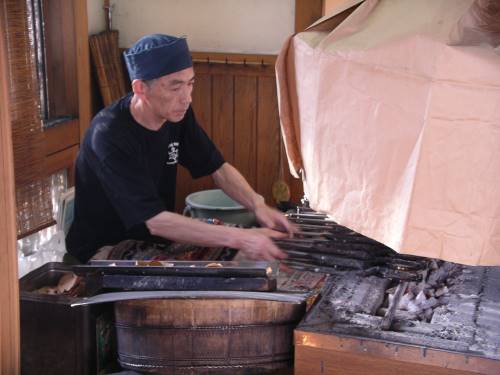
The Great Butter Shortage of '08
Saturday, May 17, 2008, 1:19 AM General, FoodPosted by stefanie Rice shortages have been in the news over the last month or so as rice-exporting countries have begun withholding supplies to feed their own people. The shortages don't appear to be affecting Japan, but the country is running low on something important: butter. For the last three weeks or so, finding butter in the stores has been hit or miss, but mostly miss. The stores kindly post signs apologizing for the lack of butter, which is cold comfort when you're contemplating dry toast for breakfast. Japan isn't generally perceived as being a dairy-centric country, so the butter deficit seems kind of surprising. To be sure, there are Japanese dairies and the Japanese do eat things like yogurt, cheese, and, ice cream. But dairy products aren't a staple in the Japanese diet like they are in the American diet, even as bread (and consequently butter) consumption has increased. None of the other dairy products appear to be in low supply (although I did notice a dearth of imported cheese today), either. Just butter. I did find a decent supply of butter in the second store I visited today, but refrained from frantically purchasing all of it.
[ 3 comments ] permalink
I made negitoro don for dinner the other night. Negitoro don is a donburi, meaning a rice bowl. It's made by topping the rice with julienned omelet, chopped raw tuna, sliced green onions, and strips of nori. 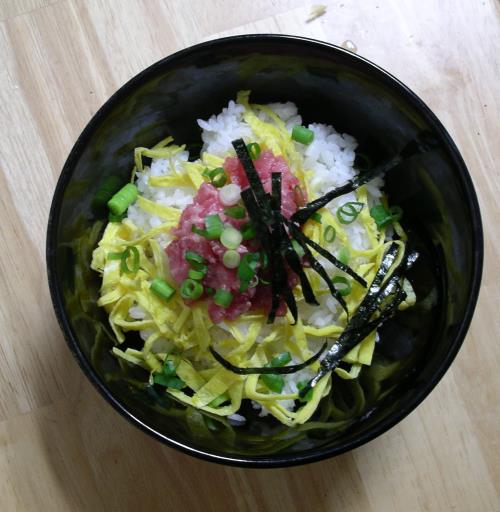 It's not a spring specialty per se, but the colors are very beautiful and springlike.
When Good Pickle Beds Go Bad
Friday, April 18, 2008, 7:07 PM FoodPosted by stefanie Oh, the horror. We've discovered the worst-tasting thing in Japan: pickles from a nuka-zuke bed that's gone off. As we mentioned in the April Fool's Day post, life around Let's Sharing HQ has gotten quite hectic. I haven't had as much time to attend to the house as I did before, so certain things have gotten neglected. Among them was the pickle bed. According to (in my opinion) the best English-language Japanese cookbook, nuka-zuke beds should be turned every day to prevent harmful bacteria from developing. Also, if the bed goes off, you should be able to tell because the bed will smell sour. My pickle bed didn't get turned for a couple of days, but when I got back to it, it smelled like it always had. It did have a thin layer of white funk on top, which I scraped off before turning the bed. I put in some daikon and let them ferment for a day or so, like usual, and they came out shrunken and softer, like usual. Then I tried to serve them. What daikon pickles should taste like: still radishy, but earthy and a little salty. What daikon pickles should not taste like: radishy spoiled milk. *sigh* Five months of cultivation down the drain.
Back Next
|
|









 Calendar
Calendar




